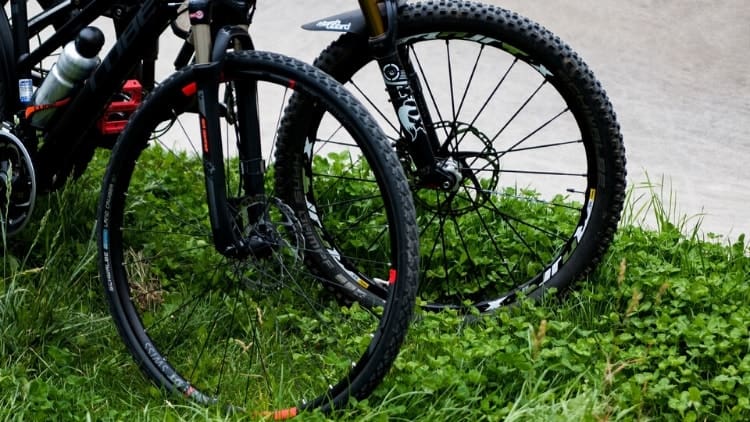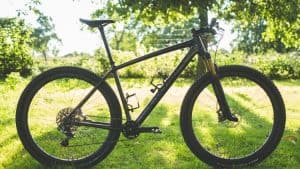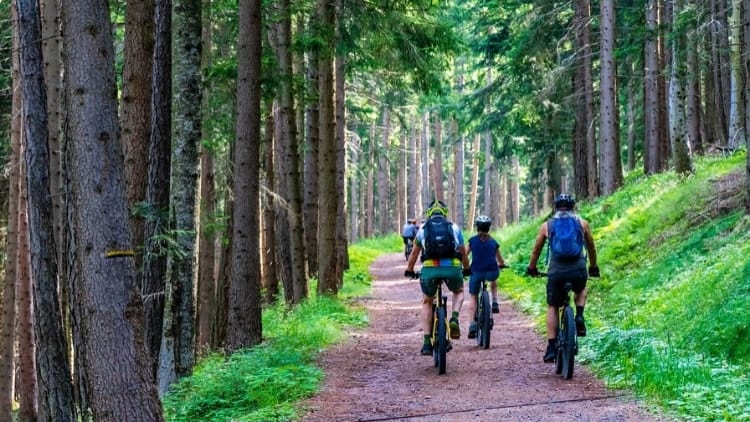If you’re in the market for a new or used Mountain Bike, you have more options than ever.
With the introduction of 2 new wheel sizes, manufacturers are designing Mountain Bikes to fit every rider and riding style.
And since each style of bike has its own advantages and disadvantages, you may be hard-pressed to decide which one would be best for you.
One of the biggest disparities in the market is between the 26er and the 29er.
On one hand, you have the tried and true 26er – a Mountain Bike that has been with Mountain Biking from the start.
On the other hand, the appeal of the 29er has seen more and more riders opting for the upgrade.
But how do you know which Mountain Bike is best for you?
In this article, we compare 26ers to 29ers, giving you the tools to decide which one is best for you.
26ers are strong, responsive, and maneuverable. They accel in areas that require frequent stop and go and are great if you need quick acceleration and handling. 29ers have a higher attack angle and help you maintain speed and stability more easily. They roll over obstacles well and offer more comfort over long distances, making them a popular option in XC riding.
For a quick breakdown of the 26er vs 29er shootout, here is an at-a-glance look at some of the points we break down in this article. If you’re interested in how these tire sizes perform on their own, check out these articles on the other popular wheel sizes available; 29er Pros and Cons, 27.5 Pros and Cons, 26er Pros and Cons
What is 26er and 29er?

Just in case these terms are new to you, I will give you a quick definition for a 26er and 29er.
A 26er is a Mountain Bike with 26-inch wheels.
Similarly, a 29er is a Mountain Bike with 29-inch wheels.
Comparing 29ers and 26ers
1. Acceleration

Winner – 26er
You will often hear riders boasting about how much faster a 29er is than a 26er, but this generalization only refers to one aspect of speed.
However, when it comes to acceleration, the 26er is a clear winner.
A 29er is a significantly larger wheel, meaning it has a lot more mass than a 26er.
While this definitely comes in handy when you’re up to speed, the law of inertia initially hurts the 29er when it starts to move.
Since the 29-inch wheel has more material to move, it is going to take you more energy and time to get it moving compared to a 26er.
On the flip side, 26ers are significantly lighter and a lot easier to get back up to speed.
For this reason, 26ers are a lot faster when it comes to acceleration.
This makes them a solid choice if you’re riding trails with a lot of switchbacks and stop-and-go action.
2. Maintaining Speed

Winner – 29er
While 26ers definitely accel when it comes to acceleration, 29ers are undoubtedly better at maintaining speed.
In fact, a 29er can feel considerably faster once you’re up to speed.
This is due to a few reasons, almost all stemming from the fact that 29ers have additional rotating mass.
The law of inertia states that an object in motion tends to stay in motion, it also explains why having more mass helps this fact.
To put it simply, once those heavier 29-inch wheels are up and moving, they are going to want to stay moving.
That isn’t the only benefit of that added rotating mass.
When all that weight is moving forward, it will also work harder to stay on course.
So things like minor bumps and knocks will have less of an effect on a 29er than they would on a 26er.
3. Traction

Winner – 29er
As any Mountain Biker will tell you, traction is one of the most important things to have when you’re out there tearing up trails.
Its one of the reasons tires are so important and why full suspensions are so beneficial, having any amount of extra traction means a faster and safer ride.
With more traction, you can take corners faster and bomb technical sections of the trail with ease.
I know I mentioned upgrades and suspension earlier, but the real determining factor for traction is how much of your Mountain Bike tire is in contact with the ground.
On top of the tread pattern, occupying more surface area with your Mountain Bike tires will give you more traction and stability.
Due to the fact that 29ers have a larger diameter wheel, they naturally have an edge over 26ers when it comes to traction.
This advantage is minimal at best, especially when you add in variables like tire pressure and tire width.
But at the end of the day, a standard 29er will always have the advantage over the standard 26er.
4. Attack Angle

Winner – 29er
When it comes to rolling over large obstacles, which bike do you think is better at getting over them?
If you chose the 29er you would be right, but you may be right for the wrong reason.
While it can be true that the larger diameter wheel helps the 29er conquer obstacles better than the 26er, the real benefit comes from the higher attack angle on 29ers.
Often overlooked, the higher attack angle that 29ers have, makes them accel in situations where they need to roll over large objects.
This higher attack angle coupled with the suppressed feeling of smaller obstacles, makes for one of the most comfortable rides of any Mountain Bike.
5. Weight

Winner – 26er
Just like traction, weight is another touchy subject when it comes to Mountain Bikes.
On one hand, you have the performance junkies who try to scrub every ounce they can, on the other, you have the people who believe weight plays a much larger role than initially thought.
Regardless, saving any amount of weight will be a benefit, as you will now be more energy efficient when pedaling.
Weight is another area where the 26er is a clear winner.
The smaller wheels really help scrub off those extra ounces, as wheelsets are some of the heaviest components on your bike.
If you’re looking to save weight or start with a lighter setup, the 26er is the clear way to go
6. Handling

Winner – 26er
Borrowing a bit from the point above, saving weight on your Mountain Bike comes with loads more benefits.
The lighter-weight 26er will be going to be the clear winner for this category.
Since 29ers are heavier than 26ers, a 26er is going to be a lot nimbler and more maneuverable than the 29er.
Especially if you’re pushing through switchbacks and navigating around super techy sections of trail.
7. Geometry

Winner – N/A
This next point is going to be a bit subjective, especially since there is such a disparity between the two sizes.
On one hand, you have the 26er, a Mountain Bike that is relatively better suited for smaller riders.
And on the other, you have the 29er, which is really well-suited for larger riders.
For this category, each rider will have their own preference, so I will leave this up to you.
8. Climbing

Winner – 29er
If there is one benefit of 29ers that is hard to argue with, it is the fact that they are such capable climbers.
The only controversy really comes into play when you talk about where this climbing ability originates.
It could be a result of the larger diameter wheels, higher attack angle, increased traction, geometry, or all the above.
Regardless, it is hard to argue with how well a 29er climbs compared to a 26er.
If you plan on doing a lot of XC or need to maintain as much speed as possible when going uphill, then a 29er is the right bike for you.
9. Strength

Winner – 26er
If you look at sports like DH and Park Riding, you will see a lot of favor for the smaller wheel sizes.
In fact, 26ers are some of the most popular Mountain Bikes on those types of trails.
You would think that the 29er would accel here since it will help you keep speed, but there are a few issues with 29ers when it comes to riding extreme trails.
The 29er wheel is not as structurally strong as the 26er.
Since the 26er has significantly shorter spokes, with a smaller wheel rotating closer to the Hub, 26ers will always be stiffer and stronger than their larger counterparts.
This is exaggerated under high-stress riding, where there tends to be a little more flex in the frame and wheels of a 29er compared to a 26er.
10. Stability

Winner – 29er
Coming from the point above about how strong and stiff 26ers are, you may be thinking that they take the lead in stability as well.
On the contrary, it is actually the 29er that offers the most stability compared to 26ers.
And there are a few factors that help the 29ers win the category for stability.
Firstly, they carry additional rotational mass in their wheels, meaning, they will work harder to remain straight on the trail.
Smaller rocks and roots that would typically jar a 26er, will be more suppressed and smoother under the tires of a 29er.
Also, that higher attack angle and rollover advantage will keep you straighter and more controlled on techy descents.
Lastly, the geometry of a 29er has the bottom bracket positioned better between the wheels, helping you keep your weight more balanced in the middle of the bike.
The result is that 29ers will keep you more secure from bouncing side to side on the trail or too far forward on the bike.
And although they can feel large at first, most riders begin to feel more and more stable on 29ers as they ride.
11. Availability

Winner – 26er
As I mentioned earlier in the post, the 26er is older than Mountain Biking itself.
With Mountain Biking starting in the 80’s, the 26er has had decades to accumulate a sizable market share, and enough parts to support the demand.
On top of this, the competition to produce quality parts has also seen a decrease in costs to support 26ers, and you can easily find replacement parts and tubes anywhere.
On the other hand, 29ers are still relatively new to the industry and they serve a smaller market than the 26ers.
It will be years before we see 29ers catch up to the 26er in terms of commonality, availability, and support.

What is a 29er Best for?
If you had time to read over the points above, I am sure you have already made your mind up as to what Mountain Bike suits you best. However, you may still be wondering what a 29er is best for.
Since 29ers are great at climbing and maintaining stability and speed, they are very great in disciplines like XC and Trail Riding.
And depending on the size of the rider, they may be the perfect bike for just about any style of trail riding.
What is a 26er Best for?
Similar to the point above, you may want to know what a 26er is best for.
With their strong wheels, aggressive geometry, and unmatched handling, 26ers are a great option for riding DH courses and Mountain Bike parks.
They also seem to fit a majority of riders, more so than the 29er, so you should have no issues using a 26er for any style of riding.
Who Should Ride a 29er?
We talked about how and where 29ers accel, but who should ride 29ers?
Based on their advantages, 29ers are a great bike for anyone who likes to ride their local trails, with the occasional Bike park or beginner DH trail.
They are perfect for riders who prioritize stability, comfort, and speed.
They are also a great fit for any rider who feels too big on the 26er bike geometry.
With the variety of frame sizes, it is relatively easy to find a 29er that fits well.
Who Should Ride a 26er?
Being the main Mountain Bike size for almost two decades, the 26er is a great fit for just about any rider and any riding style.
You will see a lot of beginner riders opting for the 26er due to its affordability and availability.
It is also a popular option for those daredevils who like to take advantage of every bump, jump, twist, turn, and hill on a trail.
Being able to easily maneuver and handle the bike will help you feel more in tune with the trail.
Conclusion
In conclusion, there is quite a difference between 29ers and 26ers.
While 29ers definitely bring some remarkable benefits to the game in terms of speed and stability, there are still too many merits to 26ers to count them out just yet.
I hope this article helped you decide for yourself.
Safe riding and good luck!

